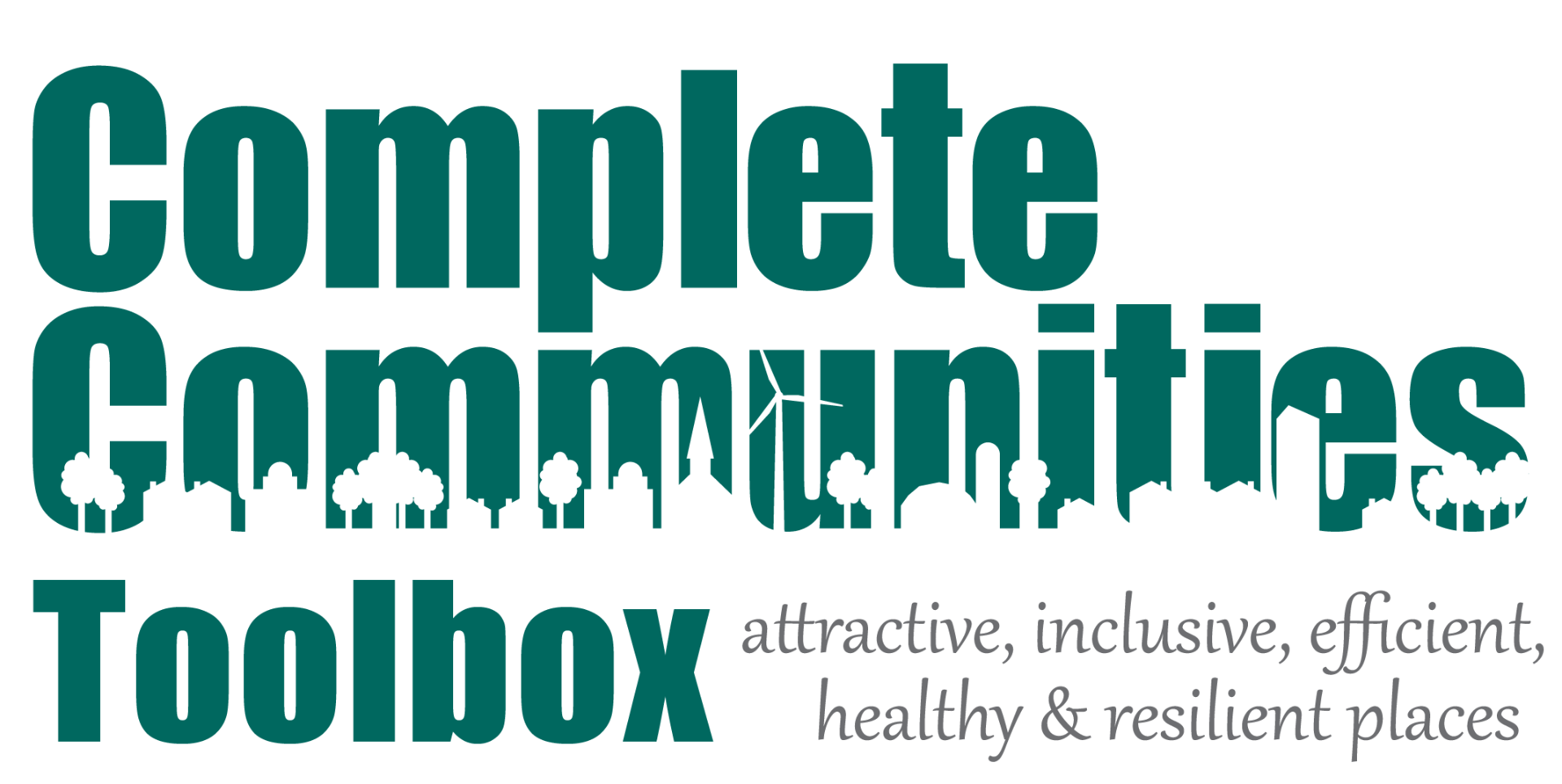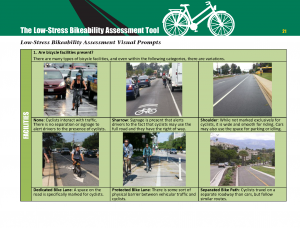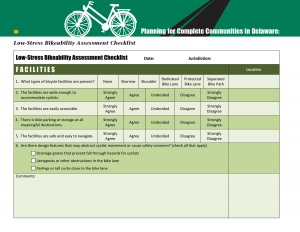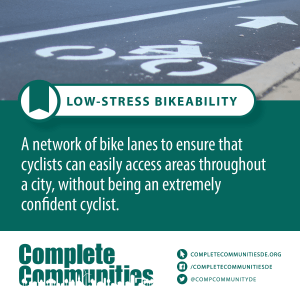 The Case for Walkable and Bikeable Communities
The Case for Walkable and Bikeable Communities
Improving conditions and opportunities for walking and bicycling, as well as integrating walking and bicycling into local-transportation networks, is critical to instituting Complete Streets, one of five elements identified in a framework to plan for Complete Communities in Delaware.
Low-income and minority communities are more likely to utilize non-automotive modes. Transportation equity ensures the development of a transportation system that is accessible, efficient, affordable, and offers safe alternatives to car travel, including bicycling.
In addition to fostering active transportation and transportation equity, bicycling promotes activity-friendly environments, environmental and economic sustainability, and “first- and last-mile” connections to transit.
What Is Low-Stress Cycling?
Low-Stress Cycling (LSC) refers to the idea that a network may be established to ensure that there are ways in which cyclist can easily access areas throughout a city, without being an extremely confident rider. A recent study indicates that while a small fraction of the population will tolerate sharing a road with heavy or fast traffic, most individuals are “interested but concerned.” The average bicyclist is willing to accept only a small degree of traffic stress.
The Delaware Department of Transportation (DelDOT) has consulted with renowned Civil Engineering Professor Peter Furth (Northeastern University) to help implement a tool called “Level of Traffic Stress (LTS) Analysis” to help plan effective, safe, and well connected bikeway networks in Delaware. DelDOT has conducted LTS analysis on roadways, streets, and pathways throughout the state. A series of maps have been produced by DelDOT, and will be available online, to help communities visualize the disconnectedness of segments within Delaware’s bicycling network and plan for future infrastructure improvements.
Bikeability Tools for Your Community
Blueprint for a Bicycle-Friendly Delaware Framework for Local Implementation Adobe Spark Page
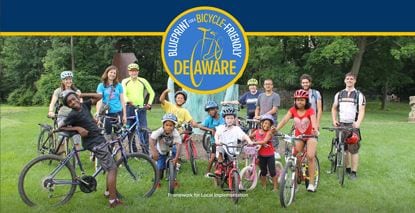 The Blueprint for a Bicycle-Friendly Delaware Framework for Local Implementation Adobe Spark Page guides local governments through the process of developing a project and coordinating with regional and state entities in accordance with the Blueprint’s goals and DelDOT’s project prioritization process. Envisioning a Delaware where high-quality bicycle networks connect destinations and cyclists of all skill levels feel safe, DelDOT created the Blueprint for a Bicycle-Friendly Delaware to establish a transparent process through which DelDOT can support bicycle-friendly planning projects led by local governments. Through participatory planning and coordination with land use strategies, locally-driven bicycle planning builds a strong foundation for bikeability by more accurately identifying the wants and needs of each specific community.
The Blueprint for a Bicycle-Friendly Delaware Framework for Local Implementation Adobe Spark Page guides local governments through the process of developing a project and coordinating with regional and state entities in accordance with the Blueprint’s goals and DelDOT’s project prioritization process. Envisioning a Delaware where high-quality bicycle networks connect destinations and cyclists of all skill levels feel safe, DelDOT created the Blueprint for a Bicycle-Friendly Delaware to establish a transparent process through which DelDOT can support bicycle-friendly planning projects led by local governments. Through participatory planning and coordination with land use strategies, locally-driven bicycle planning builds a strong foundation for bikeability by more accurately identifying the wants and needs of each specific community.
Low-Stress Bikeability Assessment Tool
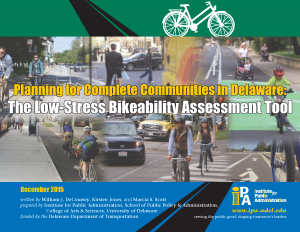 Planning for Complete Communities in Delaware: The Low-Stress Bikeability Assessment Tool is a resource for Delaware local governments that are considering ways to improve the low-stress bikeability for areas within their community. It is designed to guide local governments in evaluating the extent to which average bicycle riders can easily access low-stress areas, and in developing strategies to leverage state investments to improve local cycling networks and bicycle infrastructure. The Low-Stress Bicycling Assessment Tool should be used in combination with DelDOT’s maps to help communities target high-priority locations to plan for infrastructure improvements, bridge network connectivity gaps, and enhance low-stress conditions for the average bicyclist.
Planning for Complete Communities in Delaware: The Low-Stress Bikeability Assessment Tool is a resource for Delaware local governments that are considering ways to improve the low-stress bikeability for areas within their community. It is designed to guide local governments in evaluating the extent to which average bicycle riders can easily access low-stress areas, and in developing strategies to leverage state investments to improve local cycling networks and bicycle infrastructure. The Low-Stress Bicycling Assessment Tool should be used in combination with DelDOT’s maps to help communities target high-priority locations to plan for infrastructure improvements, bridge network connectivity gaps, and enhance low-stress conditions for the average bicyclist.
Using the Low-Stress Bikeability Assessment Tool
The Low-Stress Bicycling Assessment Tool and three-step process are designed for use in a facilitated workshop setting to engage stakeholders consisting of diverse community representatives. It is recommended that the workshop be organized and facilitated by a designated workshop leader/facilitator who is an authorized representative(s) of a Delaware local government (e.g., planner, consultant, or municipal staff member). The three-step process is designed for use by the workshop facilitator to engage stakeholders in:
Step 1: The Pre-Assessment – provides a preparation process to ensure the success of the low-stress bikeability assessment. It provides outreach to and engages community members and recommends reviewing plans and planning resources, gathering data, and selecting a study area. The downloadable Low-Stress Bikeability Visual Prompts should be provided electronically to participants in advance of the workshop to familiarize them with what to look for during the in-field bikeability assessment.
Step 2: The Low-Stress Bikeability Assessment – prepares workshop participants using a narrated presentation entitled, “Conducting a Low-Stress Bikeability Assessment: An Overview of What to Look for.” This presentation is available in the following formats:
A Low-Stress Bikeability Assessment Checklist is also available that can be downloaded, printed, copied in a double-sided format, and distributed to workshop participants. The Checklist should be used by participants during the in-field bikeability assessment to record observations and bikeability conditions. Upon completing the in-field assessment, participants immediately reconvene in a facilitated workshop setting for a debriefing and interactive mapping exercise.
Step 3: Post-Assessment – entails carrying out a process that involves prioritizing concerns, preparing a written summary, presenting findings to key stakeholders and funding entities; gaining support; and developing an action plan that considers the need for plans, policies, design changes, funding support, maintenance plans/agreements, and technical assistance.
Additional Topics Related to Bikeability
Jack A. Markell Trail
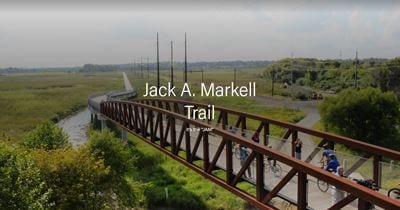 The Jack A. Markell Trail Adobe Spark Page offers a visual guide to the new Jack A. Markell pedestrian and bicycle trail. The guide presents an overview of all the trail has to offer and a detailed synopsis of the trail’s construction and background. The Adobe Spark Page also highlights the trail’s benefits to citizen health and to the community’s environment. The new trail is a monumental step toward a more healthy, active, and inclusive environment in Delaware.
The Jack A. Markell Trail Adobe Spark Page offers a visual guide to the new Jack A. Markell pedestrian and bicycle trail. The guide presents an overview of all the trail has to offer and a detailed synopsis of the trail’s construction and background. The Adobe Spark Page also highlights the trail’s benefits to citizen health and to the community’s environment. The new trail is a monumental step toward a more healthy, active, and inclusive environment in Delaware.
May is Bike Month in Delaware
 The Bike Month in Delaware Adobe Spark Page promotes the extensive bicycling events being sponsored throughout Delaware in May to showcase the many benefits of bicycling. Delaware is currently ranked the 7th most bike-friendly state in the nation thanks to state policies, dedicated funding to bicycle infrastructure and trails, safety campaigns, and strong advocacy.
The Bike Month in Delaware Adobe Spark Page promotes the extensive bicycling events being sponsored throughout Delaware in May to showcase the many benefits of bicycling. Delaware is currently ranked the 7th most bike-friendly state in the nation thanks to state policies, dedicated funding to bicycle infrastructure and trails, safety campaigns, and strong advocacy.
Road Diet
 A “Road Diet” is roadway reconfiguration that involves narrowing or eliminating travel lanes to calm traffic and increase safety of all roadway users. A classic road diet converts a four-lane undivided roadway to a three-lane roadway with a center two-way turn lane. Road diets can also remove vehicle lanes from a roadway and reallocate the extra space for other uses or traveling modes, such as parking, sidewalks, bicycle lanes, transit use, turn lanes, curb extensions, parklets, or pedestrian refuge islands. Implementing Road Diets improves mobility and accessibility for all users, including pedestrians, bicyclists, and public transit riders. This Adobe Spark Page explains benefits of road diets, provides examples traffic-calming elements, and provides Delaware-specific examples.
A “Road Diet” is roadway reconfiguration that involves narrowing or eliminating travel lanes to calm traffic and increase safety of all roadway users. A classic road diet converts a four-lane undivided roadway to a three-lane roadway with a center two-way turn lane. Road diets can also remove vehicle lanes from a roadway and reallocate the extra space for other uses or traveling modes, such as parking, sidewalks, bicycle lanes, transit use, turn lanes, curb extensions, parklets, or pedestrian refuge islands. Implementing Road Diets improves mobility and accessibility for all users, including pedestrians, bicyclists, and public transit riders. This Adobe Spark Page explains benefits of road diets, provides examples traffic-calming elements, and provides Delaware-specific examples.
Active Living
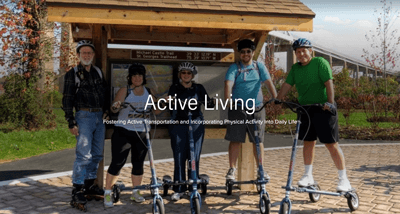 Designing communities that support active living and promote daily physical activity is a powerful way to create healthier communities. This Adobe Spark Page conveys how local governments, along with interdisciplinary community partners, can influence the extent to which residents are physically active through careful crafting of land use plans, public policies, and changes to the built environment. Focus areas for active living include active transportation modes such as walking and biking, community design, school-based physical activity, and parks and recreation programs.
Designing communities that support active living and promote daily physical activity is a powerful way to create healthier communities. This Adobe Spark Page conveys how local governments, along with interdisciplinary community partners, can influence the extent to which residents are physically active through careful crafting of land use plans, public policies, and changes to the built environment. Focus areas for active living include active transportation modes such as walking and biking, community design, school-based physical activity, and parks and recreation programs.

